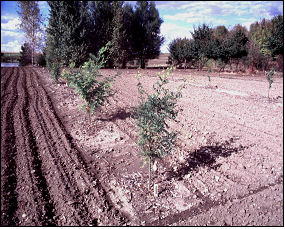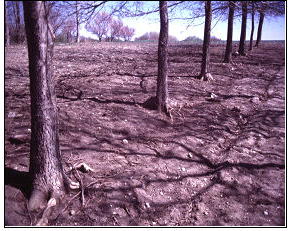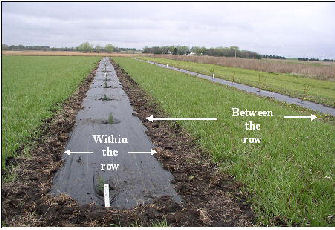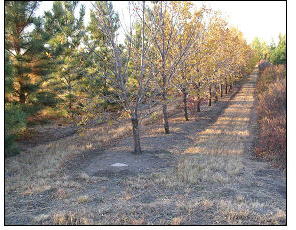Introduction
Permanent grass cover may be desirable between tree rows for erosion control, weed suppression, snow catch, wildlife use, and other environmental benefits. Tree plantings should be maintained weed free within the rows (cultivation, chemical, or fabric) 3 to 5 feet on each side, but large areas between the rows may be seeded to less competitive, shallow rooting warm-season bunchgrasses such as blue grama and/or sideoats grama. These native warm-season species are dormant during the early growing season and do not compete for moisture during this critical tree growth period. Another benefit of warm-season species is the opportunity to apply glyphosate herbicide to cool-season grasses or weeds (bromegrass, quackgrass, dandelions, etc.) when the blue grama and sideoats grama are dormant in early spring and late fall. Grass should be seeded the year of tree planting when using fabric, or anytime before trees become too crowded for equipment use (4 to 8 years of age), when fabric is not used.
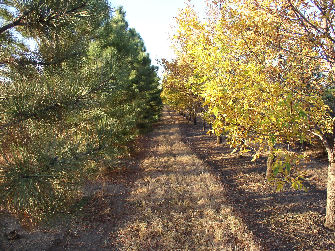
Seeding
A garden-like, clod-free seedbed should be prepared prior to seeding. Tillage should be shallow and the final seedbed must be relatively firm to be sure the planting depth does not exceed one-half inch. An adult footprint should be barely visible. Warm-season grasses should be seeded after May 1 when the soil temperature has warmed to at least 50 degrees F. Drop spreaders or rotary type spreaders can be used to broadcast the seed. Adjustment is accomplished by increasing or decreasing the size of the opening. An agitator mechanism is beneficial to keep the seed flowing. Seeding rates can be decreased by one-half when using a drill because of the more precise seed placement. If the area is broadcast seeded rather than drilled, enough loose soil must be available to cover most of the seed. Some seed on top the ground is desirable and is an indication that the seed has not been planted too deep. After raking or harrowing the seed into the soil, the new seeding should be roller packed. If a roller is not available, this can be accomplished by driving over the area with a wide-tired vehicle such as a garden tractor or an ATV. Blue grama seed is much smaller (750,000 seeds/lb) than sideoats grama seed (180,000 seeds/lb). Blue grama is generally the first choice because it is finer leaved, less expensive, and easier to mechanically seed, if it has been debearded. It is also less deeply rooted and more tolerant to mowing than sideoats grama. The larger seed clusters of sideoats grama may be more difficult to feed through a seed spreader or drill. Sideoats grama has a wider leaf blade and may be considered less attractive from an ornamental viewpoint. If a more diverse mixture is desired, the two species work well seeded together as a 50/50 mix, each at half the full seeding rate. Seeding the two species separately may simplify seeding rate calibration when seeded as a mixture. Seed is calculated on a pure live seed (PLS) basis which is purity x germination x bulk seed weight. Broadcast rates are double the drilled rates.
|
Species |
Varieties/Sources |
PLS lbs/ac Drilled Seeding Rates |
|---|---|---|
|
blue grama (Bouteloua gracilis) |
Bad River |
2.5 (full rate, seeded alone) |
|
sideoats grama (Bouteloua curtipendula) |
Pierre or Killdeer |
7.5 (full rate, seeded alone) |
Weed Control
Mowing is the best method for weed control because of the extreme sensitivity of the young tree and shrub seedlings to most broadleaf herbicides. Mowing two to four times for weed control during the year of establishment may be desirable, especially if weed density is thick enough to form a canopy that shades out the new grass seedlings. A mowing height the first year of greater than 4 inches is desirable. Warm-season grasses establish slower than most cool-season lawn grasses, so weed competition must be controlled to achieve good stands.
Mowing or Not
Blue grama and sideoats grama are tolerant of mowing and are relatively short (10 to 18 inches) in stature when left unmowed. Leaving the area unmowed is desirable for wildlife use and other environmental benefits; however, frequent mowing reduces rooting depth of the grasses and provides less water competition for the tree and shrub species. Consideration should be given to discontinuing mowing in mid-summer to let the grass grow to catch snow during the winter months which provides ground insulation and moisture retention for the following year.
Fabric Mulch Plantings
Seeding warm-season grass between the fabric strips soon after tree planting is desirable to prevent weed competition, especially from invasive species such as Canada thistle and wormwood. Tillage is also an option, but care must be taken to prevent pulling up the edges of the fabric.
|
|
|
|
Frequent tillage may cause soil erosion. |
Tree roots can be damaged by tillage and erosion. |
|
|
|
|
Frequent mowing will help reduce grass rooting depth and water competition. |
When fabric is not used, weed control can be handled by tillage (hand hoeing or rotary tree cultivation), mulch, or herbicides. Glyphosate works well when trees are larger and not as sensitive to herbicide drift. |
By Dwight Tober, Plant Materials Specialist; Craig Stange, Forester; and Wayne Duckwitz, PMC Manager.
Reprinted from USDA NRCS - North Dakota - Fact Sheet June 2007.




